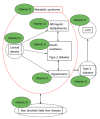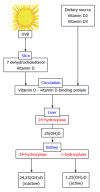Metabolic syndrome: A review of the role of vitamin D in mediating susceptibility and outcome
- PMID: 26185598
- PMCID: PMC4499524
- DOI: 10.4239/wjd.v6.i7.896
Metabolic syndrome: A review of the role of vitamin D in mediating susceptibility and outcome
Abstract
Despite the well-recognised role of vitamin D in a wide range of physiological processes, hypovitaminosis is common worldwide (prevalence 30%-50%) presumably arising from inadequate exposure to ultraviolet radiation and insufficient consumption. While generally not at the very low levels associated with rickets, hypovitaminosis D has been implicated in various very different, pathophysiological processes. These include putative effects on the pathogenesis of neoplastic change, inflammatory and demyelinating conditions, cardiovascular disease (CVD) and diabetes. This review focuses on the association between hypovitaminosis D and the metabolic syndrome as well as its component characteristics which are central obesity, glucose homeostasis, insulin resistance, hypertension and atherogenic dyslipidaemia. We also consider the effects of hypovitaminosis D on outcomes associated with the metabolic syndrome such as CVD, diabetes and non-alcoholic fatty liver disease. We structure this review into 3 distinct sections; the metabolic syndrome, vitamin D biochemistry and the putative association between hypovitaminosis D, the metabolic syndrome and cardiovascular risk.
Keywords: Atherogenic dyslipidaemia; Cardiovascular disease; Hypertension; Hypovitaminosis D; Insulin resistance; Metabolic syndrome; Non-alcoholic fatty liver disease; Type 2 diabetes mellitus; Vitamin D.
Figures


References
-
- Parker J, Hashmi O, Dutton D, Mavrodaris A, Stranges S, Kandala NB, Clarke A, Franco OH. Levels of vitamin D and cardiometabolic disorders: systematic review and meta-analysis. Maturitas. 2010;65:225–236. - PubMed
-
- Kylin E. Studien uber das hypertonie-hyperglykamie-hyperurikamiesyndrom. Zentrablfinnere Med Leipz. 1923;81:105–127.
-
- Himsworth HP, Kerr RB. Insulin-sensitive and insulin-insensitive types of diabetes mellitus. Clin Sci. 1939;4:119–152.
-
- Vague J. The degree of masculine differentiation of obesities: a factor determining predisposition to diabetes, atherosclerosis, gout, and uric calculous disease. Am J Clin Nutr. 1956;4:20–34. - PubMed
Publication types
LinkOut - more resources
Full Text Sources
Other Literature Sources

